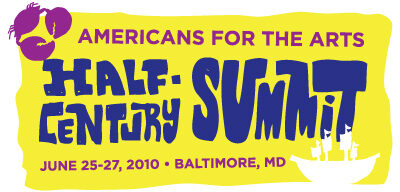Wendy Liscow, Program Officer
“Nothing creates focus more than the threat of extinction.”
This was just one of hundreds of provocative statements I heard while attending the recent Americans for the Arts’ Half Century Summit titled “Building a Vibrant Future of the Arts in America.” The sometimes inflammatory, sometimes inspiring perspectives had me pondering (and sometimes pontificating about) the state of the Arts, the importance of arts education, and the viability of arts institutions in our country. We even debated the effectiveness of using the word “Art” when trying to talk about the intrinsic value of the arts in our society. But that will be the subject of a future blog.

If you have ever attended a well-designed conference populated by great speakers and thousands of interesting and diverse attendees who all have the shared intention of discussing topics you care about, you know that your head begins to feel like a Fourth of July fireworks display shooting out hundreds of ideas, questions, and leads for research follow-up. I am still processing the four days, but I wanted to share some of the highlights from the keynote speakers.
Arianna Huffington, Co-Founder and Editor-in-Chief of The Huffington Post believes that there are plenty of smart people in the world, but there is a shortage of people with wisdom. While her vocation reveals her obvious respect for technology and new media, she recognizes that one of the unintended consequences of a society constantly linked through their “crackberry” contraptions and 24/7 access to information has yielded a “culture of distraction.” She feels that we have to find ways to carve out time for contemplation, to tap into our creative energies if we are to navigate towards wisdom. Therefore she is a big advocate for the arts, and equally appalled that it has taken her eight years to include an arts section in her online Huffington Post, which she proudly calls “unplugged and recharged.” She implored the audience to recognize the importance of the arts as not only a means for achieving wisdom but also as a pathway to empathy. She spoke eloquently about the value of arts in education as evidenced in this short excerpt from her keynote speech:
The Chairman of the National Endowment for the Arts, Rocco Landesman, discussed the future of the arts in America. He outlined his personal two-word manifesto that informs his work at the agency: “Art works.” Chairman Landesman sees multiple meanings:
1. “Art works” as a noun, the actual creations of artists. This represents the books, crafts, dances, designs, drawings, films, installations, music, musicals, paintings, plays, performances, poetry, textiles, and sculptures that are the outcomes of the creative process.
2. “Art works” as a verb. Art works on and within people to change and inspire them; it addresses the need people have to create, to imagine, to aspire to something more.
3. “Art works” as a declarative sentence: arts jobs are real jobs that are part of the real economy. Art workers pay taxes, and art contributes to economic growth, neighborhood revitalization, and the livability of American towns and cities.
Most importantly, Mr. Landesman implored the audience to seek out new partners, to collaborate and meet with leaders working from other sectors. We have to make the arts part of the national agenda and dialogue. The arts, creativity and innovation need to be at the center of the conversation, not on the periphery. He challenged us to do a much better job at broadcasting the wealth of research that highlights the value of the arts, especially that people who engage in the arts are more likely to be civically engaged in their communities.
The Chairman has been practicing what he preaches and has been reaching out to his colleagues in the Departments of Education, Transportation, Agriculture, and Housing and Urban Development, to name a few, to explore the overlaps in mission. They are finding common ground on ways to revitalize our cities and develop a creative workforce that can compete with 21st Century skills.
In collaboration with the Mayors’ Institute on City Design 25th Anniversary Initiative, they are awarding grants ranging from $25,000 to $250,000 to communities that demonstrate how arts and culture contribute to building livable and sustainable communities. He also announced a new program called “Our Town” which will provide $5 million in grants to cities who recognize the role that the arts can play in economic revitalization. New Jersey has a plethora of cities which fit that bill.
This theme of collaboration reverberated throughout the conference. It came up in one way or another in every session I attended and in every conversation I had during breaks. It is clear that arts organizations have to find new ways to work together and with those outside the field. I have watched people overcome the great resistance that comes with contemplating change of this magnitude (“nothing creates focus more than the threat of extinction”) and come up with great new partnerships and ways of configuring their institutions.
In fact, the Collaboration Prize honors the best of these ideas. I suggest you check out their website, which showcases models of collaboration among nonprofits and outlines how one can apply for the $250,000 in prizes that shine a spotlight on collaborations among two or more nonprofit organizations that cooperate to demonstrate innovative and effective responses to challenges or opportunities. Hurry though! The deadline is July 16, 2010.
